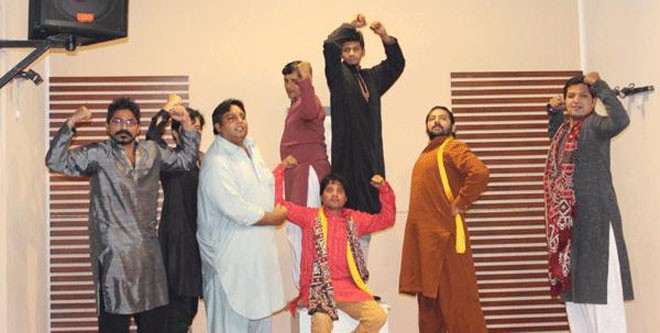

The Interactive Resource Centre (IRC) recently organised a play, titled Mard Bun, at Faiz Ghar. The play was meant to sensitise men about violence against women in a Pakistani society. The cast of the play was all male and a dupatta was used to symbolise a woman.
Interactive theatre -- sometimes called as Immersion Theatre -- removes the fourth wall on stage that separates the performer from the viewer. The audience is an active participant in the play -- they act or become part of the play by just being there. This kind of theatre is now frequently used around the world for community work, social development and purposes of creating awareness. It was popularised by famed German playwright Bertolt Brecht in the post-war Germany, and also called "Theatre of the Oppressed" in his times.
The cast of Mard Bun comprised a father, a husband, a brother and a son -- the woman existed only as a symbol in the play. It depicted how the male relatives of the woman oppress her in different situations.
The play also showed how the men, in roles outside of the home, behaved -- for instance, at workplace, school or leisure time at a gambling den etc.
Eventually, the menfolk do not come across as one-dimensional evil characters -- they are shown as ‘human’ in the sense that they themselves have been victims of violation at the hands of the more powerful in the society. But when they return home, they are likely to vent out their frustration on the women in the house.
The father labours at a factory where the owner abuses him despite the former’s age and poor health. The son is unfairly punished by his teacher at school for not learning his lesson and the punishment is essentially corporal in nature. At the gambling den, the police arrest the brother who is actually too poor to be able to gamble.
The play also stated that a bill has been tabled against domestic violence in the Punjab Assembly and, if successfully passed, it could result in the perpetrators of violence serving several months in prison and a substantial amount of fine.
Somehow Mard Bun seemed to oversimplify the message by not including any female characters. In reality, the women contribute to this vicious cycle of abuse and discrimination against other women. However, women also act as a buffer against this violence. For example, the mothers may protect their daughters and vice versa.
Mohammad Waseem, who wrote and directed the play, told the select audience who had gathered inside the very intimate Faiz Ghar that his target was men who should debate, reflect and correct what is happening rather than just indulge in male chauvinism of sorts.
Talking about the symbolic presence of the women in the play, he said, "If we had shown a real woman and her violation, it could have perpetuated violence further. So we tried to move away from depicting women as victims and instead give it an artistic flavour.
"We wanted to engage men and boys to question their role in violence against women," he added.
Interestingly, the majority of audience at Faiz Ghar was women and that too from relatively prosperous backgrounds. Mard Bun was followed by an intense debate on the issues touched upon in the play and how these could be addressed. Some blamed it on the lack of education and awareness, while others said the legal system and social mindset needed to be changed.
The only person who volunteered to play the woman’s character on stage refused to don the dupatta and insisted if men are kept under leash, the women cannot be violated. Her message didn’t go down well with much of the audience.
There was a slight problem with the title which meant "Be a man!" This prompted the question whether the traditional idea of the ‘real’ man being the exalted, heroic creature who is fair and kind to those weaker than him exists. However, the same traditional setup expects the women to meld into her family, maintain her honour and sacrifice everything for her relatives.
The title seemed to reinforce the same deep-rooted attitudes pertaining to men and what amounts to masculinity. Or, perhaps, the writer just wanted to provoke the viewer into comparing the behaviour of (the so-called) men and asses.
Some of the actors were from the IRC, while others were students or professional actors from Mandwa Theatre who had earlier performed on similar themes in educational institutes such as the Quaid-e-Azam University, union gatherings and communities like Chunna Mandi.
It was IRC’s first time at Faiz Ghar. The performance was energetic, vibrant and musical, to say the least. The language was a mix of Urdu and Punjabi. All the actors, most of whom played multiple characters, gave a stellar performance. They depicted the anguish of a common father, student, son and gambler with equal ease.
"We’ve had successful shows in Multan," said Waseem. "We have tried to create awareness on the significance of clean water through our plays. The interactive part helps the audiences to decide on the possible solutions and even mobilise as a community."